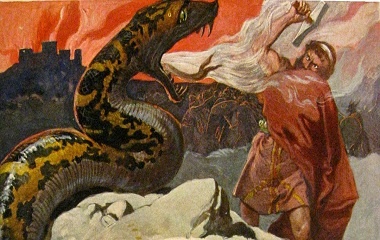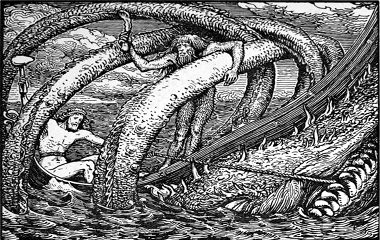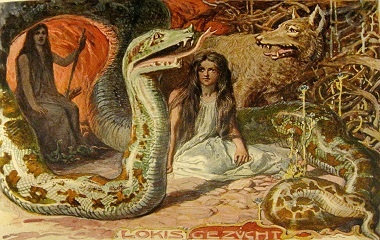Who is Jormungand?
In the depths of the ocean, a giant serpent named Jormungandr is biding his time. Prophecies tell us that he will merge at the end of time to destroy the Nine Worlds of Norse mythology, but for now, he is merely waiting…
Characteristics
Physical Description
Jormungand may be the biggest beast in Norse mythology—and that’s saying something, since the Norse mythology included Jotunheim, a kingdom full of giants!
Jormungand’s name means “earth necklace,” which is appropriate for this super-sized serpent. He is so large, he can wrap his body around Midgard and hold the end of his tail in his mouth. His mouth, which is lined with venom-dripping teeth, is large enough to swallow a god or giant whole.
Personality
Surprisingly, Jormungand’s big body does not translate into a big personality. He displays little intelligence and has no particular allegiances, although he and Thor do have numerous nasty encounters. He spends most of his time in darkness and solitude, beneath the ocean, but when he does surface, he is usually in a violent, destructive mood.
Family
Jormungand is one of the children of Loki, the god of chaos, and Angroboda, his giant mistress. He inherited his size from his mother and his destructive tendencies from his father. However, he is more animaistic than either of them.
Loki and Angroboda have two other children: Fenrir and Hel. Fenrir, a giant wolf, is just as destructive as Jormungand, plus intelligent and vengeful. Prophecies claim that the two of them will fight together during Ragnarok. Hel, ruler of the underworld, is more diplomatic than her siblings. Although she ends up in a dark position, she still manages to maintain decent relationships with the rest of the world.
When Odin, ruler of Asgard, found out about Loki and Angroboda’s children, he was enraged and fightened by them. He made all of them outcasts, hurling Jormungandr into the ocean, sentencing Hel to the underworld, and devising a plot to trap Fenrir on an island by himself.
Stories about Jormungand
The Fishing Trip
During a period of peace, Aegir and Ran, two unusually gracious giants who lived under the sea, invited the gods to a banquet, provided that the gods could bring a cauldron big enough to brew mead for everyone. This was quite an obstacle, since gods can put away huge quantities of mead, not to mention the two giants and their nine daughters who would be in attendance!
After wracking their brains, the gods thought of the giant Hymir, who had a cauldron large enough to do the job. Thor, young, reckless, and muscley, volunteered to visit Hymir in the perilous realm of Jotunheim and ask to borrow the cauldron.
Upon Thor’s arrival at his house, Hymir slaughtered three bulls, which he thought would feed them for the length of Thor’s visit. But Hymir had underestimated Thor’s legendary hunger. The young god ate two of the bulls in one meal, and Hymir angrily announced that they would need to go fishing in the morning for the next day’s food. He wasn’t going to spare any more of his cattle!
In the morning, Hymir sent Thor to find fishing bait. Again, the giant expected Thor would take a few hours hunting for small prey in the forest. Instead, Thor marched into his host’s pastures, killed the remainder of his bulls, and cut off their heads to be used as bait.
Hymir was infuriated, but after this feat of strength (and irrationality), he was afraid to confront Thor. So off they went in Hymir’s fishing boat.
Thor put his muscles to good use, rowing them out to Hymir’s usual fishing grounds. The bull heads proved to be magnificent bait. Hymir caught two whales, much to his delight, but he was again annoyed to find that Thor was not fishing. Instead, the youngster was just sitting in the board, staring out over the ocean.
At last, Hymir told Thor that they could return home, but Thor disobeyed again. He began to row the boat further into the sea. Nervously, Hymir reminded Thor that Jormungand lurked in the dark depths of the ocean. He showed off the whales he had caught and asked to return to shore, saying that the meat would be more than enough to satisfy Thor during his visit (which, Hymir was beginning to hope, would be over soon!)
But Thor ignored Hymir and rowed faster and faster, scanning the waves as he went. At last, he dropped the oar, slid one of the bull heads onto an enormous hook, and cast his line into the ocean. There was a moment of tense silence. Then, something jerked on Thor’s line so hard that the god almost toppled into the ocean. Quickly, he recovered himself and began reeling as hard as he could, the veins in his muscles popping out all over his arms.
Hymir knew that there was only one creature in the ocean strong enough to test Thor: Jormungand, He also knew that if the serpent emerged from the sea, Ragnarok—the end of the world—would begin.
Silently, the giant watched the battle between Thor and the unseen monster. Little by little, it seemed that Thor was winning. At last, the serpent’s dreadful head emerged from the water, and Thor reached for his hammer.
Quick as a wink, Hymir slipped a knife out of his pocket and cut the fishing line. The serpent zoomed back down to the ocean floor, leaving behind waves so huge that the little boat almost capsized.
Thor was so furious that he shoved Hymir overboard. Then he rowed back to shore, deposited the two whales outside of Hymir’s house, and helped himself to the cauldron he had come to borrow. Still fuming over Jormungand’s escape, Thor returned to Asgard.
Ragnarok
But Thor will get another swipe at Jormungandr during Ragnarok, the apocalyptic battle between the gods of Asgard and the giants of Jotunheim.
According to ancient prophecies, the serpent himself will set Ragnarok into emotion. After three years of relentless winter, the serpent will grow uncomfortable in his icy waters, release his tail, and head for the surface. His movement will cause earthquakes all throughout the Nine Worlds, and these earthquakes will break the bonds that held Loki and Fenrir captive.
Soon, Loki, Fenrir, and Jormungand will make their way to Asgard. Loki will lead an army of giants, bent on spilling the gods’ blood. Fenrir will run with his jaws open so wide that he swallows everything in his path, including Odin. And Jormungand will poison the sky with his terrible breath.
Eventually, Thor will fight his way through the carnage to get at Jormungand, his old enemy. The god will fight as never before, using his hammer to crush the dreaded serpent. After this triumph, Thor will turn, walk nine paces, then fall to his knees, choking on the serpent’s poison. After several seconds of agony, he too will die.
Cultural Representation
Origin
Jormungand appears in the oldest written records of Norse mythology: the Prose Edda and the Poetic Edda, dating back to the thirteenth century. He may also appear in ancient stone carvings that predate the thirteenth century, but these have been so worn down over time that it is difficult to make a positive identity of the characters.
Modern Appearances
Like many Norse characters, Jormungand has found a place in many comic books, most notably Marvel’s Thor series. Other fantasy writers—including JRR Tolkein and Neil Gaiman—have been influenced by Norse mythology, including the giant serpent, as well.










